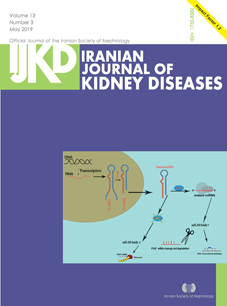Preventive Effect of Trimetazidine on Contrast-Induced Acute Kidney Injury in CKD Patients Based on Urinary Neutrophil Gelatinase-associated Lipocalin (uNGAL): A randomized Clinical Trial
Abstract
Introduction. Contrast-induced Acute Kidney Injury (CI-AKI) is a prevalent complication of chronic kidney disease (CKD) patients. The aim of this study was to evaluate the effects of periprocedural administration of trimetazidine as an anti-oxidant agent on the incidence of CI-AKI in CKD patients based on changes of Neutrophil Gelatinase-Associated Lipocalin (uNGAL) level, which has recently been introduced as an early predictor of CI-AKI.
Methods. One hundred CKD patients with a mean GFR of 50 ± 7 cc/min who were candidate for coronary angiography assigned randomly to receive (50 patients, intervention group) or not receive (50 patients, control group) trimetazidine (70mg/d) for 72 hours. CI-AKI was defined as 0.5 mg or 25% increase in serum creatinine. We also checked uNGAL before and 12h after angiography.
Results. Serum creatinine, showed a trend of less increment in the case group, although could not achieve a significant difference, there was a significant difference in urinary NGAL rise between two groups. CI-AKI was defined as 1.7 times increase in uNGAL level (12h after angiography to pre-procedurally uNGAL level ratio) according to the ROC curves. The incidence of CI-AKI according to urinary NGAL definition was 8% in the Trimetazidine group and 24% in the control group (P < .05).
Conclusion. We concluded that Trimetazidine treatment before angiography may be effective in CI-AKI prevention. Moreover, it is shown that 1.7 times increase in urine NGAL after angiography is a valuable cut off point for clinicians to discriminate high risk patients for contrast nephropathy.


